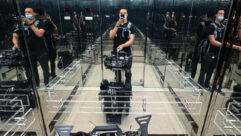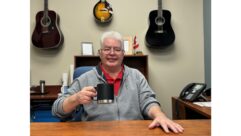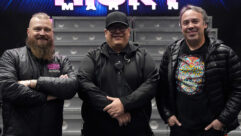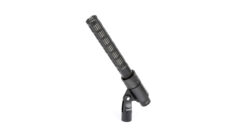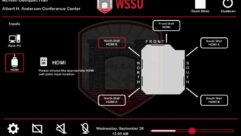
Ball Of Sound
Are soccer fields the only place you’ll see triangular-faceted icosahedrons? For now, yes, but those shapes could begin appearing in concert halls and movie theatres in the form of loudspeakers, thanks to research by the University of California Berkeley’s Center for New Music and Audio Technologies (CNMAT) and Berkeley, CA-based Meyer Sound Laboratories.
The upshot of that complex yet elegant design is that the array can be used to synthesize radiation patterns of musical instruments, create a monopole source for room measurements, and create directional beams and nulls, the CNMAT researchers wrote in their AES paper.Making wavesLeveraging DSP advancesSonic porcupinesOut of earshot
Are soccer fields the only place you’ll see triangular-faceted icosahedrons? For now, yes, but those shapes could begin appearing in concert halls and movie theatres in the form of loudspeakers, thanks to research by the University of California Berkeley’s Center for New Music and Audio Technologies (CNMAT) and Berkeley, CA-based Meyer Sound Laboratories.
At the Audio Engineering Society (AES) convention in Paris in May, CNMAT researchers presented a paper on a prototype spherical loudspeaker array that’s 10 inches in diameter — and a study in geometry. Each of the icosahedron’s 20 triangular faces has six custom 1.25-inch drivers from Meyer Sound that are paired with Class D amplifiers nestled inside the soccer ball-like array. Also inside are two pentagon-shaped circuit boards that demultiplex and process digital audio signals from the incoming Gigabit Ethernet connection before sending them on to the amplifiers.
The University of California Berkeley’s Center for New Music and Audio Technologies (CNMAT) and Meyer Sound Laboratories have developed a prototype spherical loudspeaker array. It can be used to synthesize radiation patterns of musical instruments, create a monopole source for room measurements, and create directional beams and nulls.
“One thing we can do is create a cardioid response that moves to keep a microphone in an acoustic ‘shadow’ or null, eliminating feedback,” says Adrian Freed, CNMAT’s research director. “The speaker also may be useful in a theme park where you want to ‘beam’ different sounds to different locations in the park from a few central spots instead of scattering and trying to hide many speakers.”
Spherical arrays also could be used to overcome design limitations in auditoriums and concert halls.
“Acoustic instruments radiate sounds at different levels at different frequencies in different directions,” Freed says. “Our programmable directivity loudspeaker allows us to achieve the same thing as acoustic instruments, which means all musicians can better exploit the important interaction of generated sound with reflections from the room the sound is produced in.”
The spherical array can be paired with software to produce wave field synthesis (WFS), which is similar to today’s multichannel spatial sound, with two key differences: The experience is more realistic, and there’s no sweet spot. Instead, the optimal listening position is extended across the entire listening space, such as an auditorium. Meanwhile, the effect from seat to seat varies not by quality but by what each listener hears — just as in the real world what you hear varies by where you are.
WFS is partly an offshoot of maintaining a digital signal up to the loudspeaker, enabling digital synthesis of the sound field itself. For the spherical array, WFS is one of multiple applications.
“It depends on the software control structure we choose,” Freed says. “Some applications treat the array simply as oriented drivers. Another structure that makes sense in measurement applications is spherical harmonic synthesis. Wave field is yet another where you manipulate phase and delay to synthesize virtual sources. We’re working on applications combining planar driver WFS with our speaker.”
CNMAT’s prototype array is a triangular-faceted icosahedron — similar to a soccer ball —but Freed says that other shapes are possible. The catch is that current audio product manufacturing techniques are designed primarily to crank out planar products, such as flat circuit boards and boxy loudspeaker housings. So creating arrays in other non-boxy shapes means figuring out how to work around the limitations of flat components. “I think our compromise is ingenious because everything we do is planar except the final assembly of the 20 facets,” Freed says.
CNMAT is in the early stages of evaluating the array’s potential commercial applications, but the short list of initial ones includes room acoustics measurements. It’s here that WFS is an asset because the technique leverages the digital signal chain.
“Bursting balloons and firing guns are two popular ways to generate excitations in rooms to measure their acoustic properties,” Freed says. “Unfortunately the wave front generated by these mechanisms isn’t uniform or repeatable. With our speaker, generated wave fronts will be repeatable — the system is digital all the way, including the amplifiers — and we’ll know as we complete anechoic chamber measurements how uniform the array is.”
At the Paris AES conference, using the spherical array for room acoustics generated more interest than CNMAT’s researchers expected.
“We discovered that lots of people have experimented with dodecahedral and icosahedral speakers for this kind of thing, but couldn’t overcome the practical problems to make a useful tool,” Freed says. “Only recently have the Class D amplifier chips and the necessary digital signal processing (DSP) been good enough.”
Spherical arrays could be used in at least two ways. The first is a tripod-mounted unit that can be moved around a room to simulate sources and thus assist with measurements. Another possibility is to place it near a person playing an instrument, such as in an orchestra. “Our favorite way to work is to use the house PA just for late reflections and a source model speaker for the direct source,” Freed says. “Our own performance space has a flexible gantry system, so we can hang speakers anywhere in the room at any height. We’d use suspension techniques instead of a pole to minimize stage clutter.”
Another potential initial application is source model speakers, which can be paired with acoustic instruments. For example, by using a pickup on each guitar string, it’s possible to create a more spatial-sounding amplified guitar by routing each string to a different speaker on the spherical array.
“These help you model complex radiation patterns typical of real acoustic sources, where different frequency and phase responses are needed at different directions from the source,” Freed says. “We work with musicians who use computers to make sound, often in ensembles with acoustic instrument players. They feel they’re second-class citizens because however rich and beautiful the sounds they make, they sound bland coming out of regular loudspeakers.”
To understand why — and the complexity of making it realistic — suppose that you could see the sounds emanating from a violin. Each note would look almost as unique as a snowflake. Hence the challenge of faithfully mimicking them with an electronic device. “Some notes would look like an hourglass,” says John Meyer, founder and CEO of Meyer Sound, based two miles from CNMAT. “Others would look round. Still others would look like an oval or a porcupine. To simulate an instrument is a really complicated thing.”
Why scrutinize all of those sound structures? One reason is to understand them to the point that loudspeaker technology can be refined to provide a more lifelike experience. “One of the problems with surround sound is that you can tell where the sound is coming from,” Meyer says. So we’re looking at this research to see if it will help create a more realistic environment.”
Fan-shaped concert halls could be one home for spherical arrays. These buildings often are afflicted by designs that result in sound reflections that arrive too late. “They have to come under 30 milliseconds,” Meyer says. “Otherwise, it doesn’t sound right. In fan-shaped rooms, you generally end up with them far too late.”
The obvious solution is to add loudspeakers so that the reflections arrive in less than 30 milliseconds. That works, but the downside is that the audience recognizes that the sounds are coming from a loudspeaker. “WFS could disguise its location so you wouldn’t recognize that it’s coming from a speaker, yet it allows us to give earlier reflections,” Meyer says.
MORE ON WWW.PROAVMAGAZINE.COM
For more information about wave field synthesis and the CNMAT-Meyer Sound array, check out:
- A Compact 120 Independent Element Spherical Loudspeaker Array with Programmable Radiation Patterns – CNMAT’s Paris AES paper provides more details about the research project. It’s available at www.cnmat.berkeley.edu/Research/AES2006/speakerarray/icosaspeakers.htm.
- CNMAT – The center’s website is at www.cnmat.berkeley.edu.
- Wave Field Synthesis and Analysis Using Array Technology – This 1999 IEEE paper provides a brief history of WFS and potential applications. It’s available at www.soundcontrol.tudelft.nl/Research_projects/WFS_IEEE_99.pdf.
- What’s Next: Keeping It Real– Wave field synthesis promises to do for audio what 3D does for video, September 2004
Similar issues apply in movie theatres, making them a potential market for spherical arrays. Unlike existing surround-sound systems, which provide the best experience only to audience members sitting in their sweet spot, a WFS-oriented spherical array could stretch the sweet spot throughout the theatre or auditorium. Doing so also would make the experience more realistic.
“You want the images to be where the people are onscreen,” Meyer says. “If you have a sound clue fighting a visual clue, it takes you out of the experience and into the technology.”
The wild card is how much spherical arrays will cost once they’re commercialized. Whatever the price, theatre owners might be able to make a business case for them if, like digital projection and 3D, the audio experience gives consumers one more incentive to go out for movies instead of watching them at home.
Tim Kridel is a freelance writer and analyst who covers telecom and technology. He’s based in Kansas City and can be reached at [email protected].


